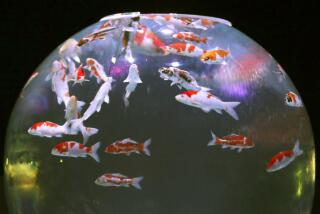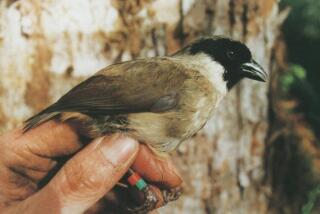Japan Seeks to Open Trade in Rare Wildlife
- Share via
TOKYO — Alarming conservationists, Japan is seeking to have three types of rare wildlife struck from the list of endangered species, opening the way for a resumption of limited international trade in ivory, whale meat and tortoise shell.
At the 10th summit of the Convention on International Trade in Endangered Species, which begins today in Zimbabwe and is being chaired by Japan, Tokyo will propose that minke whales, gray whales and Bryde’s whales living in certain oceans be downgraded from the status of “endangered” to that of “threatened” species.
Japan also wants hawksbill turtles living in Cuban waters removed from the endangered list, allowing for limited imports from Cuba of the shells of up to 500 turtles each year, according to documents from Japan’s Environment Agency.
In addition, Tokyo is supporting a bid by Zimbabwe, Botswana and Namibia to allow limited resumption of the African elephant ivory trade, which was banned by the endangered species convention, known as CITES, in 1989. The three southern African nations say their elephant populations have rebounded, and they want to sell Japan millions of dollars’ worth of ivory tusks that have been stockpiled since the ban.
The Clinton administration announced last week that it strongly opposes any weakening of the ivory ban. The United States is expected to join conservation groups in arguing that allowing even limited ivory trade will undermine the fight against poachers and make enforcement of trade bans more difficult by giving smugglers legal cover.
*
Neither side would venture a prediction last week as to how the delegates from the 135 countries attending the nearly two-week-long summit will vote on the controversial proposals.
Environmentalists warn that illegal trade in vanishing animals is not dying out. They have mustered evidence suggesting that poachers and smugglers continue to view Japan and other Asian countries as a lucrative market.
The International Fund for Animal Welfare has been distributing videotapes it says prove that elephant poaching continues in Zimbabwe. This year alone, $90,000 worth of illegal ivory from Zimbabwe was smuggled into Japan, the group’s legal counsel, Jared E. Blumenfeld, said in a telephone interview from Harare, the Zimbabwean capital.
Traffic, a British-based group that monitors trade in endangered species, reports that of the 52 tons of ivory seized from 26 countries between 1989 and 1996, nearly 19 tons were bound for Asia.
Moreover, DNA analyses of whale meat collected in Japanese and Korean markets since 1993 have turned up a wide array of scarce species, although it could not be determined when the whales had been caught.
Given the continuing destruction of animal habitats, conservationists say that wildlife conventions should, if anything, be strengthened, and they are baffled by the Japanese stance.
“We now have substitutes” for animal products, said Fred O’Regan, who heads the Massachusetts-based International Fund for Animal Welfare. “This is not the 1860s. You can make beautiful-sounding pianos without ivory. This is the age of Gore-Tex; we don’t need seal fur coats.
“We are pursuing a cruel slaughtering of species, and endangering these species terribly, for products we don’t need--including ivory,” O’Regan said.
*
Japanese officials, however, say the environmental movement has become “too emotional” in seeking to maintain bans on species that are no longer in danger.
“Scientific evidence shows that there are species whose populations are rebounding, but nonetheless people say: ‘Aren’t they pitiful? Let’s ban everything,’ ” said Kotaro Tanaka, deputy director of the import division of Japan’s Ministry of International Trade and Industry.
Japan has a moratorium on commercial whaling, but it continues to catch mainly minke whales, using a loophole in the whaling moratorium that permits “scientific research.”
President Clinton raised the U.S. opposition to this practice during Prime Minister Ryutaro Hashimoto’s visit to Washington in April, but neither side appears to have budged as a result of those talks.
The group Greenpeace says that Japan and Norway, whom it calls the world’s “whaling dissidents,” are trying to succeed at the CITES summit where they have failed at the International Whaling Commission. The commission banned whaling in 1986, but Norway protested and continues to whale.
In the past, CITES enforcers have deferred to the whaling commission on whale issues, but the environmentalists fear that if the pro-whaling nations can get a positive result at the summit, they will use it to try to influence the commission.
On the ivory issue, conservationist groups say African elephants now number about 300,000 to 580,000, down from 1.3 million in 1979. The biomass of whales in the southern oceans is estimated to be 4% to 6% of what it was 100 years ago.
“If we’re going to protect the large beasts on this planet, we have to take a different attitude,” O’Regan said. “Just because they’re starting to come back does not mean we should start shooting them.”
To some Japanese, however, the CITES regulations smack of hypocrisy by allowing Western game hunters to haul home trophies while cracking down on the Japanese tastes for whale meat and traditional carved ivory.
Tanaka noted that a loophole in the CITES treaty permits hunters to kill elephants for hunting trophies but forbids countries that have acquired ivory by culling their elephant herds from exporting it.
“We are not talking about killing them but only about using stockpiles of ivory that already exist--and only from well-managed herds,” Tanaka said.
More to Read
Sign up for Essential California
The most important California stories and recommendations in your inbox every morning.
You may occasionally receive promotional content from the Los Angeles Times.










